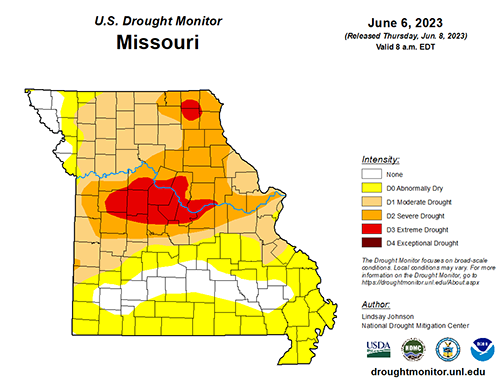STE. GENEVIEVE – The latest Missouri drought map shows worsening drought conditions in Ste. Genevieve County.
The previous drought map indicated Ste. Genevieve County to be abnormally dry. This week’s drought map shows the northwestern half of the county is in a moderate drought.
The extreme drought region in Missouri has expanded in the current map from the previous map.
An area of abnormally dry conditions has now expanded to the Mississippi River and the Bootheel.
The only areas not experiencing any form of drought are a band extending from west to east across southern Missouri and the far northwest counties.

Conditions on June 6.

Conditions last week.
Nationwide
Heavy rains fell this week across some of the western parts of the Central and Southern Great Plains, especially in the Texas Panhandle and western Oklahoma and Kansas, leading to widespread improvements to ongoing drought in the western Great Plains.
Heavy rains in the central and southern Florida Peninsula also led to improvements to ongoing drought and abnormal dryness in the southwest Florida Peninsula. Widespread degradations occurred in the Midwest and western portions of the Northeast, amid very dry and warm recent weather.
In the West, some minor improvements occurred in parts of Nevada, Utah and Idaho, where high streamflows and large precipitation amounts from the winter into May led to a reassessment of conditions. Degradations were made in a few parts of western Montana and northwest Washington, where precipitation deficits mounted amid declining soil moisture and streamflow.
Midwest
Localized heavier rains (exceeding 2 inches in spots) fell across the western reaches of the Midwest region, though large swaths of drier-than-normal weather occurred here.
Farther east, in Kentucky and the Great Lakes states, mostly or completely dry weather occurred this week, which led to mounting short-term precipitation deficits and worsening streamflows and soil moisture values.
Unusually warm temperatures, reaching or exceeding 9 degrees above normal in large portions of Michigan, Wisconsin and Minnesota, also contributed to worsening dryness. Large-scale additions and expansions of abnormal dryness and moderate drought occurred, especially along and east of the Mississippi River and in central Minnesota, where the combination of precipitation deficits, low streamflow and declining soil moisture was most prevalent. Due to similar conditions along the Missouri River in western Iowa, some expansions were made to severe drought there.
